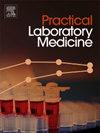Breath fingerprint of colorectal cancer patients by gas chromatography-mass spectrometry analysis preparatory to e-nose analyses
IF 1.7
Q3 MEDICAL LABORATORY TECHNOLOGY
引用次数: 0
Abstract
Colorectal cancer (CRC), according to the most recent data provided by GLOBOCAN, ranks fourth worldwide in incidence and third in mortality among all cancers. Current estimates project a global increase in colorectal cancer incidence of 60.5 % and mortality of 76.9 % between 2022 and 2045. The low sensitivity and adherence, coupled with the high costs associated with current diagnostic methods for CRC, underscore the need to explore innovative procedures for the early detection of tissue abnormalities. Existing research suggests that patients affected by this condition exhibit distinctive alterations in volatile organic compounds (VOCs) ratios in their exhaled breath.
This study presents a characterization of exhaled breath using Gas Chromatography-Mass Spectrometry (GC-MS) in patients with varying stages of the disease, as determined by conventional medical and clinical analyses. An electronic nose was utilized to develop a method aimed at rapidly analyzing a subject's exhaled breath to identify the group of belonging (healthy, affected). The aim of the study was to develop a rapid, cost-effective, and non-invasive early diagnostic system employing an electronic nose. Statistical analysis identified 12 compounds with the potential to distinguish between healthy and affected individuals and were selected for testing the application potential of the Cyranose 320 electronic nose. The ability of the method to identify the 40 subjects analyzed as Healthy Controls (HC) or CRC in terms of sensitivity and specificity (0.8 and 0.85, respectively) demonstrates the feasibility of using this method for rapid, low-cost, and non-invasive disease recognition.
气相色谱-质谱分析结直肠癌患者呼吸指纹为电子鼻分析做准备
根据GLOBOCAN提供的最新数据,结直肠癌(CRC)在全球所有癌症中发病率排名第四,死亡率排名第三。根据目前的估计,2022年至2045年期间,全球结直肠癌发病率将增加60.5%,死亡率将增加76.9%。当前CRC诊断方法的低灵敏度和低依从性,加上高成本,强调了探索早期发现组织异常的创新方法的必要性。现有的研究表明,受这种情况影响的患者在呼出的气体中挥发性有机化合物(VOCs)的比例表现出明显的变化。本研究采用气相色谱-质谱(GC-MS)对不同阶段患者的呼出气体进行表征,并通过常规医学和临床分析确定。利用电子鼻开发了一种方法,旨在快速分析受试者呼出的气体,以确定所属群体(健康,受影响)。本研究的目的是开发一种采用电子鼻的快速、经济、无创的早期诊断系统。统计分析确定了12种有可能区分健康和患病个体的化合物,并选择它们来测试Cyranose 320电子鼻的应用潜力。该方法在敏感性和特异性方面(分别为0.8和0.85)将40名受试者识别为健康对照(HC)或结直肠癌的能力表明,使用该方法进行快速,低成本和无创疾病识别的可行性。
本文章由计算机程序翻译,如有差异,请以英文原文为准。
求助全文
约1分钟内获得全文
求助全文
来源期刊

Practical Laboratory Medicine
Health Professions-Radiological and Ultrasound Technology
CiteScore
3.50
自引率
0.00%
发文量
40
审稿时长
7 weeks
期刊介绍:
Practical Laboratory Medicine is a high-quality, peer-reviewed, international open-access journal publishing original research, new methods and critical evaluations, case reports and short papers in the fields of clinical chemistry and laboratory medicine. The objective of the journal is to provide practical information of immediate relevance to workers in clinical laboratories. The primary scope of the journal covers clinical chemistry, hematology, molecular biology and genetics relevant to laboratory medicine, microbiology, immunology, therapeutic drug monitoring and toxicology, laboratory management and informatics. We welcome papers which describe critical evaluations of biomarkers and their role in the diagnosis and treatment of clinically significant disease, validation of commercial and in-house IVD methods, method comparisons, interference reports, the development of new reagents and reference materials, reference range studies and regulatory compliance reports. Manuscripts describing the development of new methods applicable to laboratory medicine (including point-of-care testing) are particularly encouraged, even if preliminary or small scale.
 求助内容:
求助内容: 应助结果提醒方式:
应助结果提醒方式:


